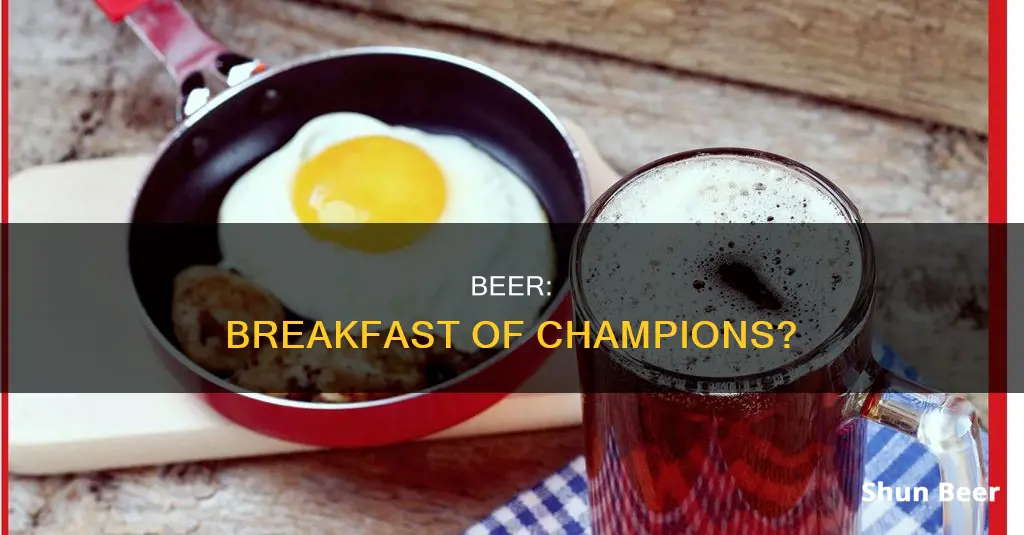
Drinking beer with breakfast is a tradition that has persisted through the ages, from the Middle Ages to the present day. In medieval times, small beer with an alcohol content of less than 2.8% was a popular breakfast drink, providing hydration and calories to fuel people through their physically demanding jobs. This tradition continued into the 20th century, with reports of families in Sweden drinking beer with their meals as recently as the 1970s. Even former US President Barack Obama has been known to enjoy a breakfast beer. Today, the variety of beer styles and flavours makes it a compelling alternative for morning imbibing, with some craft beers even incorporating breakfast-friendly ingredients like oats, coffee, and maple syrup.
| Characteristics | Values |
|---|---|
| Time Period | Middle Ages, up until the 1980s in England, 1970s in Gotland, Sweden |
| Reasoning | Beer was nourishing, part of the daily diet, and provided energy for manual labor jobs |
| Sanitation | Beer was not a replacement for water, but was considered safer to drink due to its boiling and pH levels |
| ABV | "Small beer" typically had less than 2.8% ABV, and sometimes as low as 0.5-2.0% |
| Consumption | Beer was consumed by men, women, and children, and was often drunk in addition to water |
| Nutrition | Beer was seen as healthy and nourishing, providing both calories and hydration |
| Ingredients | Beer was made with water, grain, yeast, and hops |
| Modern Alternatives | Stouts, porters, coffee IPAs, hefeweizen, witbiers, micheladas |
What You'll Learn
- In the Middle Ages, beer was drunk at breakfast in the UK
- Beer was nourishing and provided energy for manual labour jobs
- In Germany, a tall vase of hefeweizen is the traditional accompaniment to a second breakfast
- In the US, beers brewed with breakfast-friendly ingredients like oats, coffee and even scrapple are becoming popular
- In the past, beer was seen as healthy and nourishing compared to water

In the Middle Ages, beer was drunk at breakfast in the UK
In the Middle Ages, it was common for people in the UK to start their day with a beer at breakfast. This beer was known as "small beer" and had an alcohol by volume percentage of less than 2.8%, so it didn't intoxicate people. While some historians suggest that people drank beer instead of water because water was unsafe, others argue that water was accessible and drunk by most people. Instead, small beer was popular because it was full of calories, providing energy for physically demanding jobs. It was also easy to make, with only four main ingredients: water, grain, yeast, and hops. It was consumed by all ages and social classes and was seen as nourishing and part of a balanced diet.
During this period, the water supply in villages often came from nearby springs, rivers, lakes, wells, and cisterns. While castles had additional water sources, such as masonry-lined wells, the increase in population led to contamination. This, along with the lack of proper sewage systems, resulted in frequent epidemics of waterborne diseases. As a result, villagers often chose to drink ale or beer instead of contaminated water.
The beer consumed during the Middle Ages in the UK was significantly different from the beer we know today. Ale, the most common drink, was made from malted grains, water, and yeast, without hops as an ingredient. Beer, on the other hand, included hops, which added bitterness and helped preserve the drink. The addition of hops required boiling the wort, which had long-reaching consequences for the preservation, taste, and nutritional value of the beer.
While ale was the drink of choice for most of the population in medieval England, wine was also consumed by the aristocracy. The poor sometimes couldn't afford ale, but when they could, it was a staple in their diet. A peasant's breakfast typically consisted of dark rye bread and a drink of ale. Throughout the day, ale or beer accompanied meals, and supper often included vegetable pottage and more ale.
The Perfect Way to Drink Corona Beer
You may want to see also

Beer was nourishing and provided energy for manual labour jobs
In the Middle Ages, beer was a staple in people's diets, providing nourishment and energy for manual labour jobs. The beer consumed during this period, known as "small beer", typically had an alcohol by volume percentage of less than 2.8%, which was not enough to cause intoxication. It was packed with calories, providing a boost of energy that water did not. Small beer was also described as unfiltered and having a porridge-like consistency, making it a filling beverage.
Small beer was drunk in the mornings to fuel people for the day ahead, similar to how people today might consume an energy bar or bowl of cereal before work. It was consumed by all, including men, women, and children. With only four main ingredients—water, grain, yeast, and hops—it was easy to make and provided good nutritional value. While beer was not a replacement for water, it was often chosen as a drink because of its nourishing qualities and the energy it provided for physically demanding jobs.
The tradition of drinking beer with breakfast was not limited to the Middle Ages. In Germany, for example, it is customary to drink a tall vase of hefeweizen with the "second breakfast" common in Bavaria. Beer or ale for breakfast was also common in northern Europe, particularly in Belgium, and even in England until as late as the 1980s. Even as recently as the 1970s, entire families in Gotland, Sweden, were reported to be drinking beer with their meals.
Today, while drinking beer for breakfast may not be as common, there is a growing variety of beer styles and flavours that can complement breakfast. From section of text to breakfast beers brewed with breakfast-friendly ingredients like oats and coffee to European traditions like the German hefeweizen and Belgian witbier, there are plenty of options for those who want to explore the world of craft beer with their morning meal.
The Magic of Beer Thieves: How Do They Work?
You may want to see also

In Germany, a tall vase of hefeweizen is the traditional accompaniment to a second breakfast
In Germany, a tall vase of hefeweizen is the traditional drink to accompany a second breakfast. This tradition is particularly common in Bavaria, a federal state in the southeast of the country. Hefeweizen is a light German wheat beer, also known as "yeast wheat" in German, due to its unfiltered nature, which leaves yeast sediment in the beer, giving it a cloudy appearance. The beer is typically served in a large, curvaceous glass, known as a weizen vase, which showcases the beer's glow and foam cap.
The tradition of drinking beer with breakfast is not unique to Germany. In the Middle Ages, people in England also started their days with a beer, which was often consumed throughout the day while working. This beer was known as "small beer" and typically had an alcohol content of less than 2.8%, meaning it did not cause intoxication. Beer was consumed for its nutritional value, as it was full of calories and provided energy for manual labour jobs.
Hefeweizen is also believed to aid digestion and is considered a refreshing drink, making it a popular choice for a second breakfast on a warm day. The beer is typically served with a variety of foods, such as cheese, bread, pretzels, veal sausage, and radishes. While some might find it unusual to drink beer before noon, it is an accepted part of German culture, particularly during celebrations like Carnival, and is not limited by the same social norms as in other countries.
The German drinking culture is well-known, and beer is easily accessible and affordable in the country, being sold in grocery stores, gas stations, and even newspaper stands. The ease of access to alcohol has raised concerns about the potential for harmful drinking habits, but for many Germans, a morning beer is simply a normal part of their cultural traditions.
So, while having a beer with breakfast may seem unconventional to some, it is a time-honoured tradition in Germany, where a tall vase of hefeweizen is the perfect accompaniment to a second breakfast.
Poe's Drinking Habits: Beer, Wine, and More
You may want to see also

In the US, beers brewed with breakfast-friendly ingredients like oats, coffee and even scrapple are becoming popular
In the US, breakfast beers are making a comeback, with craft breweries creating beers with breakfast-friendly ingredients like oats, coffee, and even scrapple. These beers offer a unique twist on the traditional breakfast drink, providing a boost of energy and a fun drinking experience.
One example is the Maple Bacon Coffee Porter from Funky Buddha Brewery in Florida, which has garnered a dedicated following for its unique combination of smoked malts and spices, mimicking the flavours of a diner breakfast. Another popular option is the Yogi from Rogness, a chai-inspired beer that evokes the comforting taste of a bacon-topped doughnut. For those seeking a healthier option, Martin House's Day Break is a four-grain breakfast beer with barley, wheat, oats, and rye, providing a balanced blend of sweetness and ABV.
The rise of breakfast beers in the US reflects a broader trend of experimenting with unique ingredients in craft brewing. Brewers are pushing the boundaries by incorporating everything from bacon and maple syrup to tea and honey, creating complex flavour profiles that surprise and delight drinkers.
While the idea of drinking beer with breakfast may seem unconventional to some, it has a long history. In the Middle Ages, people in the UK started their days with "small beer," a low-alcohol beverage that provided nourishment and energy for manual labour jobs. Similarly, in Germany, a tall vase of hefeweizen is traditionally enjoyed with the "second breakfast" common in Bavaria.
Today, American breweries are embracing this tradition and taking it to the next level by infusing their beers with breakfast-inspired flavours. Whether it's the fruity notes of a blueberry muffin or the savoury delight of a scrapple-infused stout, these beers offer a fun and unexpected twist on the typical breakfast experience.
Beer and Atkins: What You Need to Know
You may want to see also

In the past, beer was seen as healthy and nourishing compared to water
In the past, beer was seen as a healthier and more nourishing option compared to water, especially in the Middle Ages. This notion is supported by several reasons, including the belief that water was unsafe to drink. However, historians debate this, arguing that water was accessible and free, with most towns and villages built around a water source. While water was indeed consumed by most people, it was sometimes mixed with wine or honey to improve its flavour.
The beer consumed during this period, known as "small beer," had a low alcohol content, typically less than 2.8% ABV, which meant it did not intoxicate drinkers. It was also unfiltered and had a consistency similar to porridge. Small beer was seen as a nutritious and energising drink, packed with calories to fuel manual labour jobs such as farming, blacksmithing, and stonemasonry. It was consumed by people of all ages and genders, providing both calories and hydration.
The popularity of small beer can be attributed to its nutritional value and ease of preparation. With only four main ingredients: water, grain, yeast, and hops, it was a convenient and nourishing choice for people to include in their daily diets. However, it is important to note that beer was not considered a replacement for water but rather a complementary beverage.
The perception of beer as a healthy and nourishing drink compared to water has evolved over time. While it was once seen as a source of energy and nutrition, today, it is generally not recommended to drink beer as a replacement for water or as a morning beverage. While the context and cultural norms have changed, it is fascinating to explore the historical perspective on beer as a nourishing and energising drink during the Middle Ages.
Beer Bottle or Glass: Which is the Best?
You may want to see also
Frequently asked questions
Yes, in the Middle Ages, people drank beer with their breakfast.
Beer was nourishing, full of calories, and gave people energy for their physically demanding jobs. Beer was also considered healthier than water, which was thought to be unsafe to drink.
People drank "small beer", which had an alcohol by volume percentage of less than 2.8%, so it didn't intoxicate people. It was also unfiltered and had a similar consistency to porridge.
Beer for breakfast is still common in Germany, particularly in Bavaria, where a tall vase of hefeweizen is the traditional drink to have with "second breakfast". Beer with breakfast was also common in England until as late as the 1980s, and in Sweden into the 1970s.
Stouts and porters, which have a similar flavour profile to coffee beans, are a good breakfast beer option. There are also some coffee IPAs that combine the flavours of coffee roasts and citrusy hops.







